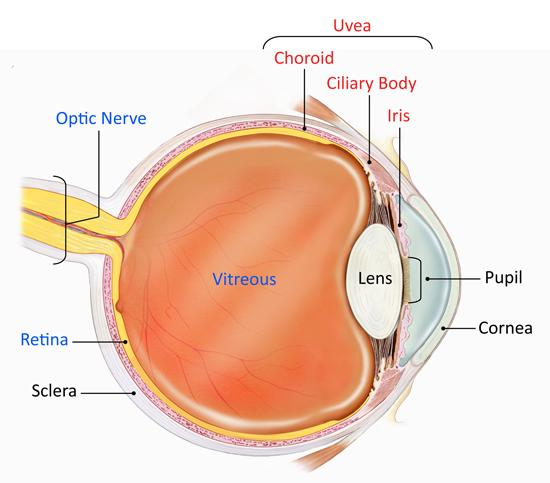Classification and terms
Anterior uveitis (iritis) - involves inflammation of the iris and adjacent structures within the anterior chamber - most common
Intermediate uveitis - inflammation affecting the ciliary body and vitreous humour
Posterior uveitis - inflammation of the choroid, retina and optic nerve head
Panuveitis - inflammation of the entire uvea
Iritis - specifically refers to the inflammation of the iris and adjacent structures within the eye’s anterior chamber which is a subtype of uveitis
Uveitis - a broader term that encompasses inflammation of the uvea. This includes the iris, but also the ciliary body and choroid.

Causes/Factors
- Usually idiopathic
- Autoimmune - Reactive Arthritis, psoriatic arthritis, Ankylosing spondylitis and inflammatory bowel disease - HLA-B27
- Infections
- Trauma
Symptoms
- Eye pain
- Redness
- Blurred vision
- Photophobia
Signs
Anterior
- Miosis - pupil constriction due to inflammation
- Hypopyon - accumulation of white blood cells in the anterior chamber
- Pupil changes in shape
Intermediate
- Vitreous cells and haze
- Snow-banking - peripheral snowflake-like exudates on the retina
Posterior
- Chorioretinal lesions
- Optic disc swelling
Investigations
- Physical Exam - assess for evidence of facial trauma, exam eyelids, conjunctiva and tarsal surface. Check visual acuity.
- Slit-Lamp Examination: Detailed evaluation of the anterior segment and fundus to assess inflammation and associated complications.
- Laboratory Tests: Blood tests for autoimmune markers, infectious serologies, and inflammatory markers.
- Imaging: Optical coherence tomography (OCT), fluorescein angiography, and ultrasonography for detailed assessment of ocular structures.
Management
If severe eye pain and a significant reduction in vision is present the person should be referred immediately for same day assessment by ophthalmology
- Non-infectious uveitis is most likely to be treated with a steroid + cycloplegic (mydriatic) drops
- For infectious uveitits an appropriate antimicrobial should be given in addition to the above
In severe or chronic cases, immunosuppressive drugs, TNFi, laser phototherapy, cryotherapy may also be considered.
Complications/red Flags
Potentially blinding condition
Accounts for up to 25% of cases of legal blindness in the developing world and 5-10% of visual impairment worldwide
- Secondary Glaucoma: Increased intraocular pressure due to inflammation or synechiae.
- Cataract Formation: Due to chronic inflammation and corticosteroid use.
- Retinal Complications: Including macular edema, epiretinal membrane, and Retinal detachment.
- Vision Loss: Severe or chronic inflammation leading to irreversible visual impairment.